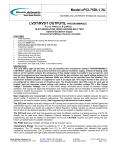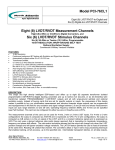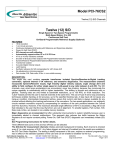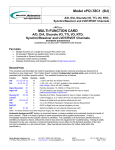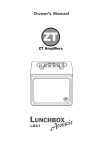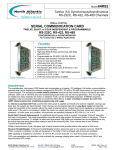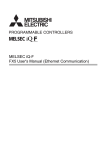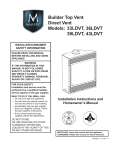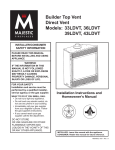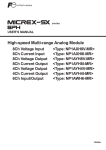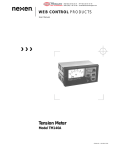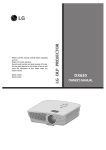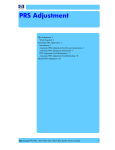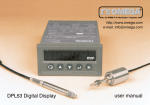Download rtX PXI 75LD1-08CF1A-62
Transcript
Model cPCI-75LD1 3U Eight (8) LVDT/RVDT-to-Digital Channels Eight (8) LVDT Measurement Channels 2-Wire or 3/4-Wire LVDT to Digital Converters Auto-ranging; Optional On-Board Excitation Commercial & Military Temperature Ranges • • • • • • • • • • • • • • • 16-bit resolution 0.025% FS accuracy Continuous background BIT testing with Excitation and Signal loss detection Self-calibrating. Does not require removal for calibration 360 Hz to 10 kHz operation Auto-ranging input between 2.0 and 28 Vrms 8 and 4-channel versions available Optional programmable reference excitation Transformer isolated LATCH feature Compensates for ±60° phase shift I/O via front panel, P2 or both Conducted cooled versions available No adjustments or trimming required Part number, S/N, Date Code, and Revision in non-volatile memory DESCRIPTION: This high-density intelligent DSP-based card incorporates up to eight (8) separate transformer isolated programmable LVDT/RVDT-to-Digital tracking converters with extensive diagnostics, and optional programmable excitation supply. Instead of buying cards that are set for specific inputs, the uniqueness of this design makes it possible to order our standard card that auto ranges between 2.0 and 28 volts. Operating frequency between 400 Hz and 10 kHz can be specified (see part number). This card can be used for 4-wire , 3-wire or 2-wire LVDT inputs. For 4-wire or 3-wire configurations the output is computed as A-B/A+B and is expressed as %FS. For 2wire configurations, the output is computed as A/B ( where A is the a-b signal of the LVDT and B is a constant reference signal ) and is expressed as %FS This card uses a derived reference ratio-metric design approach that is insensitive to magnitude, temperature, frequency and phase shift effects. The ratio-metric technique assures that the output will change only when the LVDT position changes and will ignore excitation voltage variations. The LATCH feature permits the user to read all channels at the same time. Reading will unlatch that channel. The converters utilize a Type II servo loop processing technique that enables tracking, at full accuracy, up to the specified rate. Intermediate transparent latches, on all data outputs, guarantee that current valid data is always available for any channel without affecting the tracking performance of the converters. No interrupts or waiting time are required. The optional on−board excitation is field programmable. To simplify logistics, Part Number, S/N, Date Code, and Revision are stored in non-volatile memory locations. This board incorporates major diagnostics that offer substantial improvements to system reliability because the user is alerted to channel malfunction. This approach reduces bus traffic, because the Status Registers need not be constantly polled. Three different tests (one on-line and two off-line) can be selected, The D2 Test initiates automatic background BIT testing. Each channel is checked over the programmed signal range to a measuring accuracy 0.1% FS, and each Signal and Excitation is monitored. Any failure triggers an Interrupt (if enabled) and the results are available in registers. The testing is totally transparent to the user, requires no external programming, has no effect on the standard operation of this card and can be enabled or disabled via the bus. North Atlantic Industries, Inc. Apex Signal Division 110 Wilbur Place, Bohemia, NY 11716 631.567.1100/631.567.1823 (fax) www.naii.com / e-mail: [email protected] 6/22/2005 Cage Code:OVGU1 75_LD1_A001_Rev_2.3 Page 1 of 8 The D3 Test, if enabled, starts an initiated BIT Test that disconnects all channels from the outside world and connects them across an internal stimulus that generates and measures multiple voltages to a test accuracy of 0.1%FS. Board programmer may elect to initiate a D3 self-test immediately after power on during his initialization. External excitation is not required. Any failure triggers an interrupt (if enabled) and results can be read from registers. The testing requires no external programming and can be initiated or terminated at any time via the bus. The D0 Test is used to check the card and the PCI interface. All channels are disconnected from the outside world, allowing user to write any number of input positions to the card and then read the data from the interface. External excitation is not required. SPECIFICATIONS: Number of channels: Resolution: Accuracy: Bandwidth: Input format: Input voltage Excitation voltage: Input Impedance: Frequency: Phase shift: Wrap around Self Test: Interrupts: Power: Temperature, operating: Storage temperature: Size: Weight: REFERENCE SUPPLY: Voltage: Frequency: Regulation: Output power: (applies to each channel) 4or 8 (see part number) 16-bit 0.025% FS 40 Hz. BW and tracking rate can easily be customized. 2, 3, or 4-wire LVDT or RVDT Auto-ranging from 2.0 to 28 Vrms. Transformer isolated. Not required for computation of output but should be connected to allow card to check for excitation loss. 40 kΩ min. at 360 Hz Specify between 360 Hz to 10 kHz, (See Part Number and Code Table) Automatically compensates for phase shifts between the transducer excitation and Output up to ±60° (3-wire units ignore phase shift) Three powerful test methods are described in the Programming Instructions. One Interrupt capability is implemented. + 5 VDC at 0.35 A ±12 VDC at 0.1 A without Excitation; 1.1 A for 5 VA Excitation Output "C"=0°C to +70°C; "E"= -40°C to +85°C. (See part number) -55°C to +105°C. 3U (3.94") height, 4HP (0.8") width. 100 mm x 20.3 mm x 160 mm deep 18 oz. Optional. (See part number). 2-28Vrms programmable, or 115 Vrms fixed. Resolution 0.1 Vrms, Accuracy ±2% 360 Hz to 10 kHz ±1% with 1 Hz resolution. 10% max. No load to full load. 5VA max. @ 40° min. inductive; 190mA RMS @ 2-28VAC, 45mA RMS @ 115VAC Note: Power is reduced linearly as the Reference Voltage decreases (2-28VRMS): i.e. Up 190mA can be delivered to a load for that respective reference voltage range. Principals of LVDT Operation: Typically the LVDT primary is excited by an ac source, causing a magnetic flux to be generated within the transducer. Voltages are induced in the two secondaries, with the magnitude varying with the position of the core. Usually, the secondaries are connected in series opposition, causing a net output voltage of zero when the core is at the electrical center. When the core is displaced in either direction from center the voltage increases linearly either in phase or out of phase with the excitation depending on the direction. Interfacing the LVDT to the Converter: Two common connection methods are: Primary as reference (two-wire system) This method of connection converts the widest range of LVDT sensors and is the most sensitive to excitation voltage variations, temperature and phase shift effects. Derived reference (three/four-wire LVDT) The LVDT is again excited from the primary side, but the converter reference is the sum of A + B that has constant amplitude for changing core displacement. This system is insensitive to temperature effects, phase shifts and oscillator instability and solves the identity (A-B)/(A+B) North Atlantic Industries, Inc. Apex Signal Division 110 Wilbur Place, Bohemia, NY 11716 631.567.1100/631.567.1823 (fax) www.naii.com / e-mail: [email protected] 6/22/2005 Cage Code:OVGU1 75_LD1_A001_Rev_2.3 Page 2 of 8 LVDT Coil Voltage vs. Position (IN-PHASE) (USUAL LVDT CONFIGURATION) 10.0 V Example uses 10Vrms output Vb 5.0 V Va 0.0 V POSITION -FS O Va+Vb=10V Va+Vb=10V Va-Vb=-10V Va-Vb=0V Va=0V Va=5V Vb=10V Vb=5V +FS Va+Vb=10V Va-Vb=10V Va=10V Vb=0V Various LVDT configurations OPTIONAL ON BOARD EXCITATION OPTIONAL ON BOARD EXCITATION 4 Wire 3 Wire A HI A HI a a A LO A LO B LO Excitation IN Excitation IN B LO b b B HI B HI POS = a - b a+b POS = a - b a+b Excitation Ref Hi (Monitoring) Excitation Ref Lo Excitation Ref Hi (Monitoring) Excitation Ref Lo OPTIONAL ON BOARD EXCITATION 2 Wire A HI a-b A LO a Excitation IN POS = a - b Excit. b B HI B LO Excitation Ref Hi (Monitoring) Excitation Ref Lo North Atlantic Industries, Inc. Apex Signal Division 110 Wilbur Place, Bohemia, NY 11716 631.567.1100/631.567.1823 (fax) www.naii.com / e-mail: [email protected] 6/22/2005 Cage Code:OVGU1 75_LD1_A001_Rev_2.3 Page 3 of 8 LVDT Connections: For 3,4 Wire LVDT’s, connect A and B LVDT outputs to Signal A and B inputs. Excitation is not used, but should be connected to allow card to monitor and report any excitation loss. For 2 Wire LVDT’s, connect A-B output of LVDT to card “A” input and connect external excitation voltage to card “B” input and to excitation input to allow card to monitor and report any excitation loss. PROGRAMMING INSTRUCTIONS: 00 04 08 0C 10 14 18 1C 20 24 28 2C 30 34 38 3C 40 44 48 Ch.1 Data Hi Ch.2 Data Hi Ch.3 Data Hi Ch.4 Data Hi Ch.5 Data Hi Ch.6 Data Hi Ch.7 Data Hi Ch.8 Data Hi Velocity 1 Velocity 2 Velocity 3 Velocity 4 Velocity 5 Velocity 6 Velocity 7 Velocity 8 Scale Ch. 1 Scale Ch. 2 Scale Ch. 3 read read read read read read read read read read read read read read read read r/w r/w r/w 4C 50 54 58 5C 60 64 68 6C 70 74 78 7C 80 84 88 8C 90 94 Scale Ch.4 Scale Ch. 5 Scale Ch. 6 Scale Ch. 7 Scale Ch. 8 2 or 3,4 wire Input Test angle Test (D2) verify Test Enable Active channels Interrupt Enable Interrupt Status Not Used Status, Signal Status, Reference Status, Test Latch (A & B) res. Ch.1 (A & B) res. Ch.2 r/w r/w r/w r/w r/w r/w write r/w r/w r/w r/w read read read read write r/w r/w 98 9C A0 A4 A8 AC B0 B4 B8 BC C0 C4 C8 CC D0 D4 D8 DC E0 (A & B) res. Ch.3 (A & B) res. Ch.4 (A & B) res. Ch.5 (A & B) res. Ch.6 (A & B) res. Ch.7 (A & B) res. Ch.8 Velocity scale Ch.1 Velocity scale Ch.2 Velocity scale Ch.3 Velocity scale Ch.4 Velocity scale Ch.5 Velocity scale Ch.6 Velocity scale Ch.7 Velocity scale Ch.8 Magnitude (A+B) Ch.1 Magnitude (A+B) Ch.2 Magnitude (A+B) Ch.3 Magnitude (A+B) Ch.4 Magnitude (A+B) Ch.5 r/w r/w r/w r/w r/w r/w r/w r/w r/w r/w r/w r/w r/w r/w read read read read read E4 E8 EC F0 F4 F8 FC 100 104 108 10C 110 114 118 11C 120 124 128 12C Magnitude (A+B) Ch.6 Magnitude (A+B) Ch.7 Magnitude (A+B) Ch.8 Not Used Not Used Not Used Not Used Freq. (Ref. Supply) Eo (Ref. Supply) Watchdog timer Soft reset Part Number Serial Number Date code PC Board rev. Software rev. Interface FPGA rev. FPGA rev. Board Ready read read read r/w r/w r/w write read read read read read read read read REGISTER BIT MAP Latch Outputs Test Enable Active channels Status, Test Status, Signal Status, Excitation 2 or 3,4 wire Input Interrupt (A&B) resolution D15 X X X X X X X X 0 D14 X X X X X X X X X D13 X X X X X X X X X D12 X X X X X X X X X D11 X X X X X X X X X D10 X X X X X X X X X D9 X X X X X X X X X D8 X X X X X X X X X D7 X X Ch.8 Ch.8 Ch.8 Ch.8 Ch.8 X X D6 X X Ch.7 Ch.7 Ch.7 Ch.7 Ch.7 X X D5 X X Ch.6 Ch.6 Ch.6 Ch.6 Ch.6 X X TABLE 3 Note 1 –Values are rounded off. D4 D3 X X X D3 Ch.5 Ch.4 Ch.5 Ch.4 Ch.5 Ch.4 Ch.5 Ch.4 Ch.5 Ch.4 X #4 X X 16 bit 15 bit 14 bit 13 bit 12 bit Encoder outputs INTERRUPT ENABLE & STATUS REGISTERS #1 = S/D Signal Loss #2 = S/D Reference Loss D2 X D2 Ch.3 Ch.3 Ch.3 Ch.3 Ch.3 X X 0 0 0 0 1 D1 1 X Ch.2 Ch.2 Ch.2 Ch.2 Ch.2 #2 D1 0 0 1 1 0 D0 X D0 Ch.1 Ch.1 Ch.1 Ch.1 Ch.1 #1 D0 0 1 0 1 0 ↑ #4 = S/D Test Accuracy Error (BIT) Immediately following a Power-On or System Reset, it is suggested a D3 test be implemented if a complete self test is desired. Enter Active Channels: Set the bit, corresponding to each channel to be monitored during BIT testing, in the Active Channel Register. “1”=active; “0”=not used. Omitting this step will produce false alarms because unused channels will set faults. Optional Reference/Excitation Supply: For excitation frequency, write a 16-bit word (Ex: 400 Hz = 110010000) to the Internal Excitation Frequency Register. For voltage, write an 16-bit word (Ex: 26.1Vrms =100000101) with LSB=0.1Vrms, to Internal Excitation Eo Register. It is recommended that user program the required frequency before setting the output voltage. North Atlantic Industries, Inc. Apex Signal Division 110 Wilbur Place, Bohemia, NY 11716 631.567.1100/631.567.1823 (fax) www.naii.com / e-mail: [email protected] 6/22/2005 Cage Code:OVGU1 75_LD1_A001_Rev_2.3 Page 4 of 8 Interrupt Registers: Interrupts can be enabled to relay specific problems/failures detected by the card. The problem/failures that generate these interrupts are: LVDT Signal Loss, LVDT Reference Loss, LVDT Test Accuracy Error (BIT), Each external interrupt can be enabled individually. This is accomplished by writing a “1” to the bit corresponding to desired interrupts to the Interrupt Enable Register and a “0” to disable those interrupts not used. Refer to Register Bit Map. Interrupt Status Registers: When an interrupt is initiated via a problem/failure, the Interrupt Status Register can be interrogated by a read to identify, which interrupt occurred. See Register Bit Map. Register is latched when interrupt is generated and unlatched when read. Note: This register is typically read and cleared by the device driver. Subsequent readings of this register will give clear status Selecting 2 or 3,4 Wire operation: Program the corresponding bit for the appropriate channel in the 2-3/4 Wire Register. Logic 1 = 2 wire; Logic 0 = 3 or 4 wire. Data Format: For 4-wire or 3-wire inputs, the output data is A-B/A+B and represents %FS. Format is two's complement. Maximum positive excursion is 32767 (7FFFh), 0 = 0, and maximum negative excursion is -32768 (8000h). For 2-wire input, the output data is A-B/Excitation and represents %FS. Format is two's complement. Maximum positive excursion is 32767 (7FFFh), 0 = 0, and maximum negative excursion is -32768 (8000h). Programming Scale Registers The 4-wire or 3-wire LVDT has two output voltages referred to as A and B. When connected to the A and B Signal inputs, no scaling is required because the inputs are auto-ranging, however the corresponding Scale Register can be used to scale the output code. Default settings for the Scale Registers are set to 65535 (FFFFh) which results in a full-scale output reading for full travel of the LVDT. A full-scale output reading for less than full travel of the LVDT can be obtained by writing a scale value to the corresponding Scale Register. For example, writing 32768 (8000h) to Scale Ch. 1 Register will result in channel 1 having a full-scale output reading for one-half travel of the LVDT. For 2-wire input, the default settings for the Scale Registers are 65535 (FFFFh), which result in a full-scale output reading for full travel of the LVDT for TR = 1 (transformation ratio). To achieve full output readings for TR < 1, a scale factor (SF) should be programmed into the corresponding Scale Register. This is calculated from the equation: SF =65535 (FFFFh) x TR The calculated SF value is written to the corresponding Scale Register. Read (A+B): Read binary number from the (A+B) Magnitude Register and multiply by 0.01 Volt. Only valid for 3 or 4 wire configurations. Velocity Scale Factor: To scale the Max Velocity word for 150 Strokes / Second (SpS), set Velocity Scale Factor = 4095 in HEX (max velocity word of 7FFFh being max. CW rotation, and 8000h being max. CCW rotation). Scaling effects only the Velocity output word and not the dynamic performance. Ex: To get max. velocity word @ 150 SPS: 4095(150/150) = 4095 (0FFFh) This is also the Factory setting. To get max. velocity word @ 50 SPS. 4095(150/50) = 12,285 (2FFDh) To get max. velocity word @ 9.375 SPS.4095(150/9.375) = 65,520 (FFF0h) This is also the lowest setting. Velocity Output: Read Velocity registers of each channel as a 2’s complement word, with 7FFFh being max. CW rotation, and 8000h being max. CCW rotation. When max. velocity is set to 150 SpS, an actual speed of 10 SpS CW would be read as 0888h. When max. velocity is set to 150 SpS, an actual speed of 10 SpS CCW would be read as F778h. When max. velocity is set to 50 SpS, an actual speed of 10 SpS CW would be read as 1999h. When max. velocity is set to 50 SpS, an actual speed of 10 SpS CCW would be read as E667h. To convert a velocity word, for example E667h, into rps: If max. velocity set to 50 SpS, then SpS = 50 x E667h / 32,768 = 50 x -6,553 / 32,768 = -10 SpS Latch: All channels may be latched by writing a “1” to D1 in the Latch Register. Reading a particular channel will disengage the latch for that channel. Writing a 0 to this register will disengage latch on all channels. North Atlantic Industries, Inc. Apex Signal Division 110 Wilbur Place, Bohemia, NY 11716 631.567.1100/631.567.1823 (fax) www.naii.com / e-mail: [email protected] 6/22/2005 Cage Code:OVGU1 75_LD1_A001_Rev_2.3 Page 5 of 8 D2 Test Enable: Writing a “1” to the D2 bit of the Test Enable Register initiates automatic background BIT testing. Each channel is checked over the programmed Signal range to a measuring accuracy 0.1%FS. An Interrupt will be set to indicate an accuracy problem. A “0” deactivates this test The testing is totally transparent to the user, requires no external programming, has no effect on the standard operation of this card and can be enabled or disabled via the bus. The results are available in Test Status Registers. The card will write 55h to the Test D2 Verify Register when D2 Test is enabled. User can periodically clear to 00h and then read the Test D2 Verify Register again, after 30 seconds, to verify that background BIT testing is activated. In addition, each Signal and Excitation input is continually monitored. Any failure triggers an Interrupt (if enabled) and the results are available in the Signal and Excitation Status Registers. Status, Test: Check the corresponding bit of the Test Status Register, for status of BIT testing for each active channel. A ”1” =Accuracy OK; “0” = failed. Channels that are inactive are also set to “0”. (Test cycle takes 45 seconds for accuracy error). Any Test status failure, transient or intermittent will latch the Test Status Register. Reading will unlatch register. Status, Excitation: Check the channel’s corresponding bit of the Excitation Status Register, for status of the Excitation input for each active channel. A ”1” = Excitation. ON, “0” = Excitation. loss. Channels that are inactive are also set to “0”. (Excitation loss is detected after 2 seconds). Excitation monitoring is disabled during D3 or D0 Test. Any Excitation status failure, transient or intermittent will latch the Excitation Status Register. Reading will unlatch register. Status, Signal: Check the channel’s corresponding bit of the Signal Status Register, for status of the input signals for each active channel. A "1" = Signal ON, “0” = Signal loss. Channels that are inactive are also set to “0”. (Signal loss is detected after 2 seconds). Any Signal status failure, transient or intermittent will latch the Signal Status Register. Reading will unlatch register. D3 Test Enable: A complete Self-Test, is enabled, when writing a “1” to D3 in the Test Enable Register. This starts an initiated BIT test that disconnects all channels from the outside world and connects them across an internal stimulus that generates multiple test voltages that are measured to a test accuracy of 0.1%FS. Test cycle takes about 10 seconds and results can be read from the Test Status Register when D3 changes from “1” to “0”. External excitation is not required. An Interrupt, if enabled will be generated if a BIT failure is detected (See Interrupt Register). Testing requires no external programming and can be terminated by writing “0” to D3 of the Test Enable Register. Signal and Excitation monitoring is disabled during D3 test. D0 Test Enable: Checks the card and interface. Writing a “1” to D0 in the Test Enable Register disconnects all channels from the outside world, allowing user to write any number of input positions to the card in the LVDT/D Test Position Register and then reads the data from the PCI bus (allow 50 ms before reading). External excitation is not required. Signal and Excitation monitoring is disabled during D0 test. (A&B) Encoder Resolution: Enter required resolution, for each channel, per above table (Register Bit Map). Can be changed on the fly. Encoder outputs are optional, see part ordering information. Default is 12 bit encoder output. Watchdog Timer: This feature monitors the Watchdog Timer Register. When it detects that a code has been received, that code will be inverted within 100 µSec. The inverted code stays in the register until replaced by a new code. User, after 100 µSec, should look for the inverted code to confirm that the processor is operating. Soft Reset: Write an integer “1” to Soft Reset Register, then clear to 0 before 50ms elapses. CAUTION: Register is level sensitive and for proper card operation, the logic level “1”, or pulsewidth, must be <= 50ms. Considering minimum and maximum, 1 μs < pulsewidth <= 50ms. Processor reboots in about 400 ms, after which calibration procedures begin. This function is equivalent to a power-on reset. Part Number: Read as a 16-bit binary word from the Part Number Register. A unique 16 bit code is assigned to each model number. Serial Number: Read as a 16 bit binary word from the Serial Number Register. This is the serial number of that particular board. Date Code: Read as decimal number from the Date Code Register. Four digits represent YYWW (Year, Year, Week, Week). North Atlantic Industries, Inc. Apex Signal Division 110 Wilbur Place, Bohemia, NY 11716 631.567.1100/631.567.1823 (fax) www.naii.com / e-mail: [email protected] 6/22/2005 Cage Code:OVGU1 75_LD1_A001_Rev_2.3 Page 6 of 8 Rev Levels: There are a total of 6 Revision Level Registers, which are listed below. Each register is defined as 16 bits. The integer value of that particular register corresponds to the actual revision. Rev level PCB Rev level DSP Rev level FPGA Rev level Interface FPGA Board Ready: When board initialization is completed (& auto-cal for A/D modules), after as much as 10 seconds, the board is ready for access and the Board Ready register is set to “AA55”. Software - PCI Programming This section provides programmers the information needed for developing drivers other than those supplied. The following information resides in the PCI configuration registers: Device ID = 7531h Vendor ID = 15ACh Rev = 01h Subsystem ID = 000115ACh Base Address = Assigned by the PCI BIOS. Interrogate the PCI BIOS for this information. Required Address space = 1K for each card. Front panel Connector: DD-50P, Mate: DD-50S (not supplied) Pin 25 8 9 24 7 23 Ch. 1 A Lo B Hi A Hi B Lo RHi RLo Pin 22 5 6 21 20 4 Ch. 2 A Lo B Hi A Hi B Lo RHi RLo Pin 2 19 3 18 35 36 Ch. 3 Pin Ch. 4 Pin Ch. 5 Pin Ch. 6 Pin Ch. 7 Pin Ch. 8 Pin Ref. Output A Lo 42 A Lo 43 A Lo 45 A Lo 31 A Lo 49 A Lo 1 Ref Hi Out B Hi 37 B Hi 26 B Hi 28 B Hi 30 B Hi 32 B Hi 34 Ref Lo Out A Hi 41 A Hi 27 A Hi 29 A Hi 47 A Hi 33 A Hi B Lo 38 B Lo 10 B Lo 12 B Lo 14 B Lo 16 B Lo RHi 39 RHi 11 RHi 13 RHi 15 RHi 17 RHi RLo 40 RLo 44 RLo 46 RLo 48 RLo 50 RLo Rear panel J2 connector Pin D20 E21 E20 D21 E19 D19 Ch. 1 A Lo B Hi A Hi B Lo RHi RLo Pin D17 E18 E17 D18 C19 B19 Ch. 2 A Lo B Hi A Hi B Lo RHi RLo Pin D15 E16 E15 D16 E14 D14 Ch. 3 A Lo B Hi A Hi B Lo RHi RLo Pin D12 E13 E12 D13 C14 B14 Ch. 4 Pin Ch. 5 Pin Ch. 6 Pin Ch. 7 A Lo D2 A Lo D5 A Lo D7 A Lo B Hi E3 B Hi E6 B Hi E8 B Hi A Hi E2 A Hi E5 A Hi E7 A Hi B Lo D3 B Lo D6 B Lo D8 B Lo RHi E4 RHi C4 RHi E9 RHi RLo D4 RLo B4 RLo D9 RLo Pin D10 E11 E10 D11 C9 B9 Ch. 8 Pin Ref. output A Lo E22 Ref Hi Out B Hi D22 Ref Lo Out A Hi B Lo RHi RLo Do not connect to any undesignated pins North Atlantic Industries, Inc. Apex Signal Division 110 Wilbur Place, Bohemia, NY 11716 631.567.1100/631.567.1823 (fax) www.naii.com / e-mail: [email protected] 6/22/2005 Cage Code:OVGU1 75_LD1_A001_Rev_2.3 Page 7 of 8 Code Table Code 01 02 03 04 05 06 Frequency (Hz) 400 2.8K - 3.2K 2K 2.69K 2.5kHz 7kHz Notes See code list addendum for descriptions of code 50 and above PART NUMBER DESIGNATION 75LD1- XX X X X X - XX TOTAL NUMBER OF CHANNELS 04 = 4 Channels 08 = 8 Channels CODE (See Code Table) ENCODER/COMMUTATION - = Without Encoder/Commutation option E = With Encoder/Commutation option ENVIRONMENTAL C = 0°C to +70°C E = -40°C to +85°C H = E With Removable Conformal Coating K = C With Removable Conformal Coating OPTIONAL REFERENCE SELECTION 0 = No “On Board Reference” A = 2-28 VRMS output contact factory for other temperature requirements EXCITATION CONNECTIONS 1 = One Common Excitation input tied to the Excitation Supply 2 = Individual Excitation Inputs MECHANICAL F = Front Panel I/O only B = Front Panel I/O and J2 I/O P = J2 I/O only W= P with Wedgelocks (cPCI only, not PXI) Note: J2 connections can not be used for Analog signals in a PXI chassis. Analog Outputs must be via the front panel I/O only North Atlantic Industries, Inc. Apex Signal Division 110 Wilbur Place, Bohemia, NY 11716 631.567.1100/631.567.1823 (fax) www.naii.com / e-mail: [email protected] C = 115 VRMS fixed output 6/22/2005 Cage Code:OVGU1 75_LD1_A001_Rev_2.3 Page 8 of 8 Revision Page Revision Description of Change 1.2 Initial Release 1.3 Engineer Date GS 05/01/02 Corrected Header for 8 (not 16) channels GS 06/05/02 1.4 For proper Soft Reset operation, 1μ < pulsewidth <=50ms. GS 6/27/02 1.5 Removed 2-13.5 volt reference option (from spec, and PN) GS 6/28/02 8/28/02 9/5/02 1.6 Adds Board Ready GS 1.7 Removed all references to Save and Post. Update Graphic Va-Vb = -10, first column. GS 1.8 Edited D3 test to imply POST feature GS 9/6/02 1.9 Corrected LDVT -> to LVDT in diagram title. GS 9/19/02 2.0 Conducted cooled versions available GS 7/7/4 2.1 Removes Wedgelock option from PN. Conduction cooled version is NOT available GS 4/19/5 2.2 Adds Wedgelock option back to PN. Conduction cooler version is available. GS 6/22/5 New Address KL 04/25/07 2.3 North Atlantic Industries, Inc. Apex Signal Division 110 Wilbur Place, Bohemia, NY 11716 631.567.1100/631.567.1823 (fax) www.naii.com / e-mail: [email protected] 6/22/2005 Cage Code:OVGU1 75_LD1_A001_Rev_2.3 Page 9 of 8











